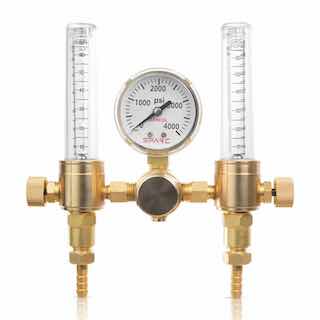TIG Welding Techniques with a Torch Switch and 2t settings
This week we are showing a few tips about different Tig welding techniques using a torch switch.
A
torch switch like the one in the video is just an on/off switch with no
amperage control. That means whatever amperage you have set on the
machine is what you get when you press the switch.
Well its almost that simple. But not quite, because there are 2 settings that sometimes come into play called upslope and downslope.
When you use a torch switch, on newer inverter tig welding machines, you can usually select either a 2t or a 4t function.
This article is about 2t tig welding techniques. We will go over the 4t function in a future video.
Here is how 2t works if you set the upslope to zero and downslope to zero:
1. press trigger to start welding,
2. let off the trigger to stop welding.
pretty simple huh?
Setting the uplsope and downslope is fairly simple too if you remember these are both timer settings.
for example setting the upslope to 5 works like this:
press trigger and you get the start amperage. Then it takes 5 seconds for the amperage to ramp up to whatever you have the main amperage set.
Why use upslope? because sometimes it helps you out to have a few seconds to get your filler rod in position, adjust your torch angle, etc.
Why use downslope? because shutting off amps all at once leaves a crater eye. and sometimes a crack. It all depends on material type and thickness, application, shape of part, etc. but being able to taper off amperage is helpful.
3 tig welding techniques you can do with a torch switch:
1. quick burst tack welding
2. tig welding thick steel parts where amperage control is not as critical as on thin stuff
3. manual pulse tig on aluminum
for quick burst tacking , set both upslope and downslope to zero. ( or any other application where you want a basic on/off situation)
all I do is adjust the stickout of the tungsten to where I can rock the torch in and touch the metal. Next, I rock the torch back just a tiny bit and press the trigger as quickly as I can. some machines come with a spot timer that is adjustable enough to get a really quick burst but I prefer to just do it manually.
For welding parts where I dont need that much amperage control, like the thick steel parts in the video, I usually set both upslope and downslope to around 4 seconds.
For manual pulse tig like on the aluminum tubing in the video, I set upslope to zero, and downslope to around 2 1/2 seconds ....just long enough for me to reposition the torch for the next pulse without the arc stopping.
Well, thats it for this week.
Oh, and one more thing.
you saw me propping next to the weld using a tig finger. If you have ever welded aluminum tubing, you know how quickly it gets hot and that usually means either propping farther away than you would really like to.
Why not just keep a Tig Finger in your pocket and whip it out when you need it? Grab one and dont look back.
"Keeps you cool, wont let you down"
see more videos on tig welding techniques














